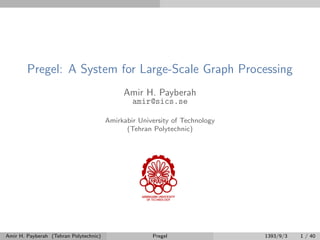The document discusses Pregel, a graph-parallel processing platform developed at Google for large-scale graph processing. Pregel is inspired by the bulk synchronous parallel (BSP) model and uses a vertex-centric programming model where computation is viewed as messages passed between graph vertices. In Pregel, applications run as a series of supersteps where vertices can update themselves and pass messages to other vertices, with global synchronization between supersteps. This model is better suited for graph problems compared to more general data-parallel systems.













































![Example: PageRank
Update ranks in parallel.
Iterate until convergence.
R[i] = 0.15 +
j∈Nbrs(i)
wjiR[j]
Amir H. Payberah (Tehran Polytechnic) Pregel 1393/9/3 28 / 40](https://image.slidesharecdn.com/pregel-150126091822-conversion-gate01/85/Graph-processing-Pregel-46-320.jpg)
![Example: PageRank
Pregel_PageRank(i, messages):
// receive all the messages
total = 0
foreach(msg in messages):
total = total + msg
// update the rank of this vertex
R[i] = 0.15 + total
// send new messages to neighbors
foreach(j in out_neighbors[i]):
sendmsg(R[i] * wij) to vertex j
R[i] = 0.15 +
j∈Nbrs(i)
wjiR[j]
Amir H. Payberah (Tehran Polytechnic) Pregel 1393/9/3 29 / 40](https://image.slidesharecdn.com/pregel-150126091822-conversion-gate01/85/Graph-processing-Pregel-47-320.jpg)











